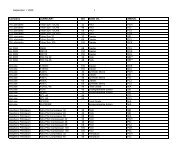AMSOIL P.i. - A Study in Performance (G2543) - Synthetic Motor Oil
AMSOIL P.i. - A Study in Performance (G2543) - Synthetic Motor Oil
AMSOIL P.i. - A Study in Performance (G2543) - Synthetic Motor Oil
Create successful ePaper yourself
Turn your PDF publications into a flip-book with our unique Google optimized e-Paper software.
Picture B - Injector spray pattern before P.i. treatment<br />
Picture C - Injector spray pattern after P.i. treatment<br />
By measur<strong>in</strong>g oxygen, the oxygen sensor <strong>in</strong> the exhaust stream is able to calculate how much<br />
gasol<strong>in</strong>e the <strong>in</strong>jectors are spray<strong>in</strong>g, as well as the air/fuel ratio. Although vehicles are usually<br />
equipped with many fuel <strong>in</strong>jectors (one per cyl<strong>in</strong>der), only one oxygen sensor monitors them<br />
all. Through the oxygen sensor, the computer is able to determ<strong>in</strong>e if the eng<strong>in</strong>e is receiv<strong>in</strong>g<br />
the right amount of fuel. Deposit build-up on the <strong>in</strong>jectors reduces the fuel flow. When the<br />
computer determ<strong>in</strong>es that the eng<strong>in</strong>e is not receiv<strong>in</strong>g enough fuel, it <strong>in</strong>creases fuel flow from<br />
all the <strong>in</strong>jectors <strong>in</strong> the fuel system. Although this solution would work well if all the <strong>in</strong>jectors<br />
lost fuel flow at the same rate, <strong>in</strong>jectors almost always plug at different rates based upon their<br />
operat<strong>in</strong>g temperatures (<strong>in</strong>board cyl<strong>in</strong>ders typically run hotter) and <strong>in</strong>dividual manufactur<strong>in</strong>g<br />
tolerances.<br />
Port fuel <strong>in</strong>jector deposits have a significant impact on fuel economy and emissions because<br />
they plug <strong>in</strong>jectors at uneven rates, and the eng<strong>in</strong>e cannot compensate for <strong>in</strong>dividual cyl<strong>in</strong>ders.<br />
For example, a four-cyl<strong>in</strong>der eng<strong>in</strong>e could have two plugged <strong>in</strong>jectors, while the other two may<br />
only be mildly plugged or not plugged at all. The oxygen sensor <strong>in</strong>dicates to the computer that<br />
the eng<strong>in</strong>e is not receiv<strong>in</strong>g enough fuel, so it <strong>in</strong>creases the fuel supply to all four cyl<strong>in</strong>ders.<br />
Now the two <strong>in</strong>jectors that were plugged are provid<strong>in</strong>g more fuel, but it still may not be enough,<br />
while the two <strong>in</strong>jectors that weren’t plugged are provid<strong>in</strong>g more fuel than necessary. As a<br />
result, it creates a situation where two cyl<strong>in</strong>ders are runn<strong>in</strong>g rich and the other two are runn<strong>in</strong>g<br />
lean. Remov<strong>in</strong>g port fuel <strong>in</strong>jector deposits allows the eng<strong>in</strong>e to operate as it was designed,<br />
improv<strong>in</strong>g fuel economy, lower<strong>in</strong>g emissions and contribut<strong>in</strong>g to improved drivability (reduced<br />
stumbl<strong>in</strong>g, stall<strong>in</strong>g, hesitation and rough idle) and <strong>in</strong>creased power.<br />
As more holes are<br />
added to director<br />
plate designs, they<br />
must be made<br />
<strong>in</strong>creas<strong>in</strong>gly smaller<br />
<strong>in</strong> order to ma<strong>in</strong>ta<strong>in</strong><br />
the pressure drop.<br />
Injector Deposit<br />
Clean-Up Test<br />
The ASTM D5598 Injector Clean-<br />
Up PFI Test was performed to test<br />
the fuel <strong>in</strong>jector clean<strong>in</strong>g power of<br />
<strong>AMSOIL</strong> P.i. <strong>Performance</strong> Improver.<br />
Start<strong>in</strong>g with a new, clean fourcyl<strong>in</strong>der<br />
2.2L Chrysler eng<strong>in</strong>e<br />
with new fuel <strong>in</strong>jectors (an eng<strong>in</strong>e<br />
particularly sensitive to <strong>in</strong>jector<br />
deposits), the car was driven and<br />
allowed to build up deposits for<br />
2,728 miles on normal gasol<strong>in</strong>e.<br />
Afterwards, deposit levels and<br />
<strong>in</strong>jector flow rates were measured.<br />
The <strong>in</strong>jectors did not develop<br />
deposits at the same rate, as two<br />
of the <strong>in</strong>jectors were fouled >15%,<br />
one was fouled >10% and one was<br />
% Flow<br />
105<br />
95<br />
85<br />
75<br />
Injector 1<br />
Injector 2<br />
Injector 3<br />
Injector 4<br />
Test Method: CARB<br />
Build-up<br />
1000 2000 3000<br />
Total Test Miles<br />
Graph A<br />
Pass<br />
Clean-up<br />
with P.i.<br />
Two of the four dirty <strong>in</strong>jectors tested were fouled >15% and<br />
another was fouled >10%. After one tank of operation on<br />
<strong>AMSOIL</strong> P.i., all <strong>in</strong>jectors returned to >95% fl ow.<br />
almost perfectly clean. After the measurements were recorded, the <strong>in</strong>jectors were placed back<br />
<strong>in</strong> the car and the car was filled with a tank of gas treated with P.i. As seen <strong>in</strong> Graph A, all<br />
<strong>in</strong>jectors returned to >95% flow after one tank of operation on P.i.<br />
<strong>AMSOIL</strong> P.i.: A <strong>Study</strong> <strong>in</strong> <strong>Performance</strong> 3




